Blog categories
Blog archive
RSS Blog posts tagged with 'table'
Blog Filters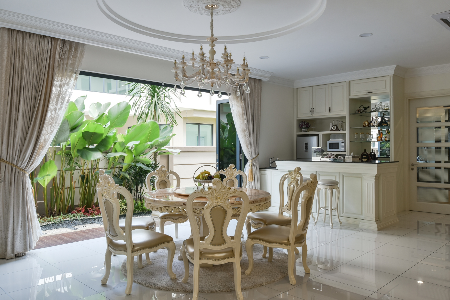
Dine in Style: A Dining Table Buying Guide for Every Homeowner
Friday, November 20, 2020
As the dining space is arguably the most likely part of a home where family members can be expected to congregate, the selection of a dining table is probably the most important decision to be made - at least with regards to furnishings. We understand that the wide range of styles and materials available for dining tables may be overwhelming for most, so we put together this definitive guide to assist you in your search for the perfect dining table.
Material
The materials commonly used in dining tables greatly affect their longevity in terms of substance as well as style. Hardwoods, metals, tempered glass, stone, and even mould-injected plastics tend to be the materials of choice for long-term furnishings expected to endure years of physical impacts and spills. On the end of the scale would be the lightweight or flat-pack designs composed of veneered wood composites such as plywood and fibreboard. These engineered composites are significantly less durable, showing a tendency to warp when subjected to excessive moisture or heat. On the plus side, tables made of these materials are preferred for short-term and low-frequency applications as they tend to be easier to repack and move by design.
Natural materials such as hardwoods and stone tend to be porous, requiring regular maintenance and a coat of varnish or sealer to prevent permanent staining from everyday use - however artisans attest to some aesthetic benefits derived from a deliberate patina providing a personalized tinge to these natural materials.
 Natural materials such as hardwoods and stone tend to be porous, requiring regular maintenance and a coat of varnish or sealer to prevent permanent staining from everyday use. From iN Design Bumper Issue 2016. Image Credit: Latitude Design
Natural materials such as hardwoods and stone tend to be porous, requiring regular maintenance and a coat of varnish or sealer to prevent permanent staining from everyday use. From iN Design Bumper Issue 2016. Image Credit: Latitude Design
Metals would also need to be protected, albeit to a lesser degree by virtue of their inherent durability. Metal furnishings are at the highest risk of deterioration by rust when used outdoors, and especially when lacking a protective coating. To ensure the longest possible lifespan, a metal dining table should be powder-coated in carbon to provide protection against scratches.
Dining tables sporting tempered glass tops are much sought after as they provide a balance between eye-pleasing aesthetics and durability in their reflective surfaces. While glass is naturally lower in impact resistance when compared to metal, modern tempered glass is manufactured at such high pressures that its durability is virtually guaranteed in everyday circumstances.
 Dining tables sporting tempered glass tops are much sought after as they provide a balance between eye-pleasing aesthetics and durability in their reflective surfaces. From iN Design Bumper Issue 2016. Image Credit: The Roof Studio
Dining tables sporting tempered glass tops are much sought after as they provide a balance between eye-pleasing aesthetics and durability in their reflective surfaces. From iN Design Bumper Issue 2016. Image Credit: The Roof Studio
Mould-injected plastics are likely the most economical and durable solution for outdoor applications but as white plastics tend to turn yellow with age, care should be taken to minimize their exposure to direct sunlight.
Size
One of the most crucial considerations for your dining table would be its dimensions, as a dining table that is too large for its space forces diners to squeeze through narrow gaps between the wall and their seats. We recommend allowing for gaps between 90 centimetres to 1.3 meters (or 36 to 50 inches) of space between a dining table and the surrounding walls to enable diners to comfortably take their seats.
 We recommend allowing for gaps between 90 centimetres to 1.3 meters (or 36 to 50 inches) of space between a dining table and the surrounding walls to enable diners to comfortably take their seats. From iN Design issue #66. Image Credit: Design Base Interior
We recommend allowing for gaps between 90 centimetres to 1.3 meters (or 36 to 50 inches) of space between a dining table and the surrounding walls to enable diners to comfortably take their seats. From iN Design issue #66. Image Credit: Design Base Interior
Diners should be provided with ample elbow room to allow for a relaxing dining experience. Our recommendations are to provide each diner with around 60 to 70 centimetres (or 24 to 28 inches) of space. With this rule in mind, one can accurately determine the appropriate size for a dining surface needed to serve a particular number of diners.
Shape
The shape of a dining table should also be considered, as rectangular tables tend to accommodate fewer diners than round tables of a similar size. To calculate the number of diners appropriate for a round table: multiply the diameter of a table by the value of Pi (π: 3.14) and divide the result by the amount of space needed for each diner.
 Assuming a minimum of 60 centimetres (or 24 inches) of space needed per diner, a round table with a diameter of 1.5 meters can easily accommodate 7 diners. From iN Design Bumper Issue 2016. Image Credit: Turn Design Interior
Assuming a minimum of 60 centimetres (or 24 inches) of space needed per diner, a round table with a diameter of 1.5 meters can easily accommodate 7 diners. From iN Design Bumper Issue 2016. Image Credit: Turn Design Interior
Assuming a minimum of 60 centimetres (or 24 inches) of space needed per diner, a round table with a diameter of 1.5 meters can easily accommodate 7 diners, or up to 8 diners with a negligible reduction in elbow room. A rectangular table that is 1.5 meters long can only seat a total of 6 diners - one at each end and two along each length.
 A rectangular table that is 1.5 meters long can only seat a total of 6 diners – one at each end and two along each length. From iN Design issue #71. Image Credit: Pocket Square
A rectangular table that is 1.5 meters long can only seat a total of 6 diners – one at each end and two along each length. From iN Design issue #71. Image Credit: Pocket Square
The choice of a dining table's shape has a noticeable effect on the space it occupies. Round tables, while capable of accommodating a greater number of diners, tend to appear imposing in tight quarters and are generally not suitable for small dining spaces as a result. Conversely, the more conventional rectangular dining tables take up the most space, requiring long and narrow spaces to avoid appearing out of proportion.
 Round tables, while capable of accommodating a greater number of diners, tend to appear imposing in tight quarters. From iN Design Bumper Issue 2015. Image Credit: D'concepto Design
Round tables, while capable of accommodating a greater number of diners, tend to appear imposing in tight quarters. From iN Design Bumper Issue 2015. Image Credit: D'concepto Design
 Rectangular dining tables take up the most space, requiring long and narrow spaces to avoid appearing out of proportion. From iN Design issue #78. Image Credit: Living Space Creative Design
Rectangular dining tables take up the most space, requiring long and narrow spaces to avoid appearing out of proportion. From iN Design issue #78. Image Credit: Living Space Creative Design
Height
Dining tables are commonly manufactured within a standard range of heights, from 710 to 760 centimetres (or between 28 to 30 inches), which makes finding them a relatively easy task. The key considerations to apply when looking at the various heights of dining tables is that the surface should be sufficiently low to provide an ergonomic resting place for arms, while the support structures beneath the surface should be sufficiently high to prevent knocking against knees.
To conserve floor space for smaller dining areas, open layout concepts, or simply for variation - consider counter-height tables, measuring up to 910 centimetres (or 36 inches) in height to join with kitchen counters, or bar-style tables around one meter in height.
 Consider counter-height tables, measuring up to 910 centimetres (or 36 inches) in height to join with kitchen counters. From iN Design magazine issue #74. Image Credit: Nu Infinity
Consider counter-height tables, measuring up to 910 centimetres (or 36 inches) in height to join with kitchen counters. From iN Design magazine issue #74. Image Credit: Nu Infinity
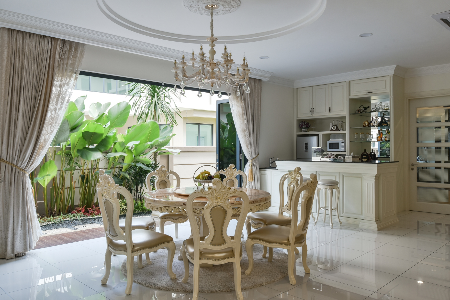
Dine in Style: A Dining Table Buying Guide for Every Homeowner
Friday, November 20, 2020
As the dining space is arguably the most likely part of a home where family members can be expected to congregate, the selection of a dining table is probably the most important decision to be made - at least with regards to furnishings. We understand that the wide range of styles and materials available for dining tables may be overwhelming for most, so we put together this definitive guide to assist you in your search for the perfect dining table.
Material
The materials commonly used in dining tables greatly affect their longevity in terms of substance as well as style. Hardwoods, metals, tempered glass, stone, and even mould-injected plastics tend to be the materials of choice for long-term furnishings expected to endure years of physical impacts and spills. On the end of the scale would be the lightweight or flat-pack designs composed of veneered wood composites such as plywood and fibreboard. These engineered composites are significantly less durable, showing a tendency to warp when subjected to excessive moisture or heat. On the plus side, tables made of these materials are preferred for short-term and low-frequency applications as they tend to be easier to repack and move by design.
Natural materials such as hardwoods and stone tend to be porous, requiring regular maintenance and a coat of varnish or sealer to prevent permanent staining from everyday use - however artisans attest to some aesthetic benefits derived from a deliberate patina providing a personalized tinge to these natural materials.
 Natural materials such as hardwoods and stone tend to be porous, requiring regular maintenance and a coat of varnish or sealer to prevent permanent staining from everyday use. From iN Design Bumper Issue 2016. Image Credit: Latitude Design
Natural materials such as hardwoods and stone tend to be porous, requiring regular maintenance and a coat of varnish or sealer to prevent permanent staining from everyday use. From iN Design Bumper Issue 2016. Image Credit: Latitude Design
Metals would also need to be protected, albeit to a lesser degree by virtue of their inherent durability. Metal furnishings are at the highest risk of deterioration by rust when used outdoors, and especially when lacking a protective coating. To ensure the longest possible lifespan, a metal dining table should be powder-coated in carbon to provide protection against scratches.
Dining tables sporting tempered glass tops are much sought after as they provide a balance between eye-pleasing aesthetics and durability in their reflective surfaces. While glass is naturally lower in impact resistance when compared to metal, modern tempered glass is manufactured at such high pressures that its durability is virtually guaranteed in everyday circumstances.
 Dining tables sporting tempered glass tops are much sought after as they provide a balance between eye-pleasing aesthetics and durability in their reflective surfaces. From iN Design Bumper Issue 2016. Image Credit: The Roof Studio
Dining tables sporting tempered glass tops are much sought after as they provide a balance between eye-pleasing aesthetics and durability in their reflective surfaces. From iN Design Bumper Issue 2016. Image Credit: The Roof Studio
Mould-injected plastics are likely the most economical and durable solution for outdoor applications but as white plastics tend to turn yellow with age, care should be taken to minimize their exposure to direct sunlight.
Size
One of the most crucial considerations for your dining table would be its dimensions, as a dining table that is too large for its space forces diners to squeeze through narrow gaps between the wall and their seats. We recommend allowing for gaps between 90 centimetres to 1.3 meters (or 36 to 50 inches) of space between a dining table and the surrounding walls to enable diners to comfortably take their seats.
 We recommend allowing for gaps between 90 centimetres to 1.3 meters (or 36 to 50 inches) of space between a dining table and the surrounding walls to enable diners to comfortably take their seats. From iN Design issue #66. Image Credit: Design Base Interior
We recommend allowing for gaps between 90 centimetres to 1.3 meters (or 36 to 50 inches) of space between a dining table and the surrounding walls to enable diners to comfortably take their seats. From iN Design issue #66. Image Credit: Design Base Interior
Diners should be provided with ample elbow room to allow for a relaxing dining experience. Our recommendations are to provide each diner with around 60 to 70 centimetres (or 24 to 28 inches) of space. With this rule in mind, one can accurately determine the appropriate size for a dining surface needed to serve a particular number of diners.
Shape
The shape of a dining table should also be considered, as rectangular tables tend to accommodate fewer diners than round tables of a similar size. To calculate the number of diners appropriate for a round table: multiply the diameter of a table by the value of Pi (π: 3.14) and divide the result by the amount of space needed for each diner.
 Assuming a minimum of 60 centimetres (or 24 inches) of space needed per diner, a round table with a diameter of 1.5 meters can easily accommodate 7 diners. From iN Design Bumper Issue 2016. Image Credit: Turn Design Interior
Assuming a minimum of 60 centimetres (or 24 inches) of space needed per diner, a round table with a diameter of 1.5 meters can easily accommodate 7 diners. From iN Design Bumper Issue 2016. Image Credit: Turn Design Interior
Assuming a minimum of 60 centimetres (or 24 inches) of space needed per diner, a round table with a diameter of 1.5 meters can easily accommodate 7 diners, or up to 8 diners with a negligible reduction in elbow room. A rectangular table that is 1.5 meters long can only seat a total of 6 diners - one at each end and two along each length.
 A rectangular table that is 1.5 meters long can only seat a total of 6 diners – one at each end and two along each length. From iN Design issue #71. Image Credit: Pocket Square
A rectangular table that is 1.5 meters long can only seat a total of 6 diners – one at each end and two along each length. From iN Design issue #71. Image Credit: Pocket Square
The choice of a dining table's shape has a noticeable effect on the space it occupies. Round tables, while capable of accommodating a greater number of diners, tend to appear imposing in tight quarters and are generally not suitable for small dining spaces as a result. Conversely, the more conventional rectangular dining tables take up the most space, requiring long and narrow spaces to avoid appearing out of proportion.
 Round tables, while capable of accommodating a greater number of diners, tend to appear imposing in tight quarters. From iN Design Bumper Issue 2015. Image Credit: D'concepto Design
Round tables, while capable of accommodating a greater number of diners, tend to appear imposing in tight quarters. From iN Design Bumper Issue 2015. Image Credit: D'concepto Design
 Rectangular dining tables take up the most space, requiring long and narrow spaces to avoid appearing out of proportion. From iN Design issue #78. Image Credit: Living Space Creative Design
Rectangular dining tables take up the most space, requiring long and narrow spaces to avoid appearing out of proportion. From iN Design issue #78. Image Credit: Living Space Creative Design
Height
Dining tables are commonly manufactured within a standard range of heights, from 710 to 760 centimetres (or between 28 to 30 inches), which makes finding them a relatively easy task. The key considerations to apply when looking at the various heights of dining tables is that the surface should be sufficiently low to provide an ergonomic resting place for arms, while the support structures beneath the surface should be sufficiently high to prevent knocking against knees.
To conserve floor space for smaller dining areas, open layout concepts, or simply for variation - consider counter-height tables, measuring up to 910 centimetres (or 36 inches) in height to join with kitchen counters, or bar-style tables around one meter in height.
 Consider counter-height tables, measuring up to 910 centimetres (or 36 inches) in height to join with kitchen counters. From iN Design magazine issue #74. Image Credit: Nu Infinity
Consider counter-height tables, measuring up to 910 centimetres (or 36 inches) in height to join with kitchen counters. From iN Design magazine issue #74. Image Credit: Nu Infinity
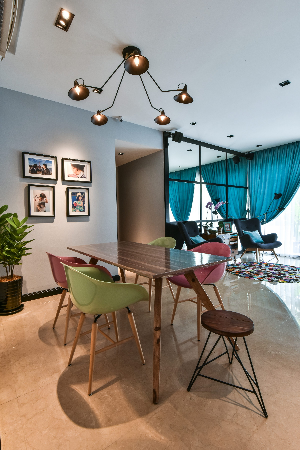
How to Select the Best Dining Table for Your Dining Room
Friday, November 20, 2020
The dining table is most often the central feature of dining spaces, contributing the most towards the décor by virtue of their size - which makes their selection all the more crucial.
The dining room is probably the one part of a home that sees the most people at any time - and whether people are just passing through or sitting down for meals, the table will have an impact on how diners perceive the space, the home, and the homeowner. As the selection of dining room furniture will likely be an event that does not occur very often, we wanted you to be as informed as possible before you set out on your journey towards your new dining table.
Material
 Interior design by: Viincology
Interior design by: Viincology
The kind of material that your dining table is made out of will have an effect on its lifespan and its appearance. Long-lasting materials such as hardwoods, metals, tempered glass, stone, and even mould-injected plastics are preferred for dining tables that are expected to endure many years of heavy use. Conversely, lightweight or flat-pack furniture composed of veneered wood composites such as plywood or fibreboard are made with mobility and affordability in mind, these materials are preferred for short-term arrangements by virtue of their being easier to pack and transport by design.
 Interior design by: Viincology
Interior design by: Viincology
Lightweight composite materials such as plywood or fibreboard are known to be significantly less durable, as they show a tendency to warp when subjected to excessive moisture or heat. Tougher natural materials such as hardwoods and stone tend to be porous, which entail regular maintenance with coats of varnish or sealer to prevent unintended staining from everyday use.
 Interior design by: SNG Conceptwerke
Interior design by: SNG Conceptwerke
Due to their being porous and softer than metal, wooden surfaces entail a greater degree of care to ensure their longevity. Oil-based varnishes should be applied to wooden surfaces at the point of manufacture - and periodically afterwards to prevent unintentional staining. Despite the higher level of maintenance required, metal furnishings tend to rust - especially when used outdoors, while wooden furnishings take on a characteristic smoothness and polished sheen as they age.
Size
 Interior design by: Hoe & Yin Design Studio
Interior design by: Hoe & Yin Design Studio
Having too large a table surface will result in a cramped dining space, while restricting diners to a small surface leads to elbows bumping in uncomfortably close quarters. It is the recommendation of most decorators to provide each diner with around 60 to 70 centimetres (or 24 to 28 inches) of space for adequate elbow room, and around 90 centimetres to 1.3 meters (or 36 to 50 inches) between a dining table and the surrounding walls for diners to comfortably get in and out of their seats.
Shape
 Interior design by: IDS Interior Design
Interior design by: IDS Interior Design
The shape of your dining table will determine the number of diners you can host and will affect the space it occupies. While round tables are capable of accommodating a greater number of diners, they tend to appear larger in small dining spaces - the conventional rectangular dining table takes up the most space, needing long and narrow spaces to avoid appearing overly large.
 Interior design by: IDS Interior Design
Interior design by: IDS Interior Design
To calculate the number of diners appropriate for a round table: multiply the diameter of a table by the value of Pi (π: 3.14) and divide the result by the amount of space needed for each diner. Using the previously mentioned minimum of 60 centimetres (or 24 inches) of space needed per diner, a round table with a diameter of 1.5 meters can easily accommodate 7 diners, or up to 8 diners with a negligible reduction in elbow room - while a rectangular table of similar size (at 1.5 meters long) can only seat a total of 6 diners – one at each end and two along each length.
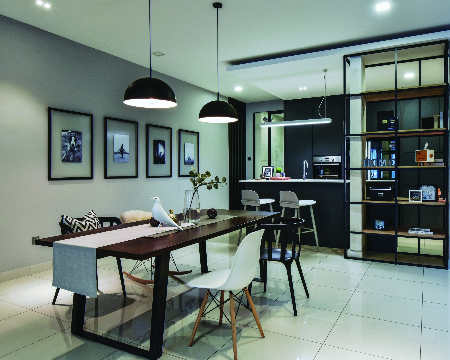
Creating a Well-Composed Dining Room
Friday, November 20, 2020
Whether you have a large formal dining hall or a small area for daily mealtimes next to the living room, here’s how to put together different interior features to ensure your dining room looks and feels good from every angle.
 Interior design by: The Roof Studio
Interior design by: The Roof Studio
Whether you’re hosting a family dinner or just getting together for a weeknight meal, the dining room is where people come together. From modern to classic, there are many ways to turn this room into a cosy space that is perfect for entertaining your guest in comfort and style. Gone are the days when you need to have matching tables and chairs at your dining table. The trend is to go for features that complement each other. If you are going for a modern look, aim for furniture that has clean lines and sturdy material. Also, make good use of tableware to pull it all together.
Palette Play
It's easier to create a well-designed dining room when you have a strong starting point to guide you - this is where having a colour palette in mind can really help you focus on the elements you can use. If you love a certain colour and have a particular hue in mind for your dining room, start with this colour.
 Interior design by: The Roof Studio
Interior design by: The Roof Studio
For example, yellows are a great way to create a bright and vibrant dining space. Start with light yellow for the walls, then add on bolder shades of complementary tones like blues. However if you are not confident about using bold colours, go for a neutral and monochrome palette, like the dining room pictured here.
Accent Pieces
Don't just stop at tables and chairs in the dining room. If you have space, accent furniture like a console or an armoire can work wonders to help create a focal point and enhance those blank walls that envelope your dining area. However, choose something that blends with your dining table.
 Interior design by: Chaplins Furniture
Interior design by: Chaplins Furniture
In this dining room, a bright blue console works beautifully to bring attention to the table. The decorative accessories and mirror above the console add a lively look to the atmosphere. The bold pendant lamps are also just the perfect features to balance off the the space.
Material Maneuver
 Interior design by: Mode Interior Style
Interior design by: Mode Interior Style
Mixing and matching different materials in the dining room can offer a dramatic yet personalised effect to your space. Balance is key, as you don't want a single material to overwhelm the rest. Also offset hard and sturdy surfaces with soft furnishing to give your space a sense of cosy warmth.
 Interior design by: Mode Interior Style
Interior design by: Mode Interior Style
In this dining room, there is a bold variety of materials ranging from solid wood and faux grass to brick-like finishes on the opposite wall. The addition of the marble-like feature wall balances off the dark-coloured surfaces. The use of wood flooring just around the dining space also helps to demarcate the space clearly.
Vibrant Variety
Another way to mix materials is through a variety of different seating and surfaces. Mix-and-match seating works well when each chair or bench is of a similar style and shape. Also think about what you use as centrepieces on your dining table.
 Wood and ratan are making a huge comeback in the dining room, but those from the lighter range are preferred. Go for a Zen effect but break from the monotony with stronger tones and textures. Interior design by: iDecorate
Wood and ratan are making a huge comeback in the dining room, but those from the lighter range are preferred. Go for a Zen effect but break from the monotony with stronger tones and textures. Interior design by: iDecorate
In this warm and neutral dining room, the woven rattan chairs bring a sense of similarity to the entire set, but if you look closely, every single piece is individual in style. To further enhance the room, a tableware set with a similar look and feel is used.
Trendy Tableware
 Interior design by: iDecorate
Interior design by: iDecorate
Finally, complete your dining room with beautiful tableware to bring everything together. When it comes to choosing a dinnerware set, the choice is usually a matter of personal taste. It’s a necessity for any table, but it also sets the mood for a meal. For example, formal china can make a momentous occasion feel even more special, while basic stoneware is a good match for a low-fuss weeknight dinner.
 Colour coordinate your tableware by having a neutral backdrop and then enhancing it with bolder tones through colourful plates, bowls, and mug. Interior design by: Dunelm
Colour coordinate your tableware by having a neutral backdrop and then enhancing it with bolder tones through colourful plates, bowls, and mug. Interior design by: Dunelm
In the example here, a white dinner set complemented by green accents bring out a nature-inspired theme that enhances the wood dining table. To add texture, fabric placemats tone down the hard surfaces and introduce a lush quality to the space.
 Interior design by: Dunelm
Interior design by: Dunelm
Article by: Lily Wong
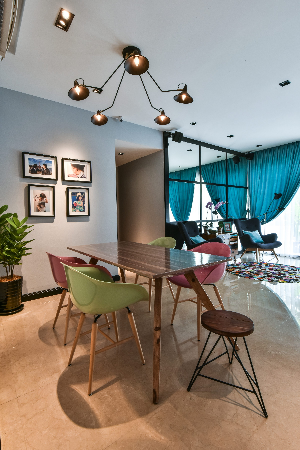
How to Select the Best Dining Table for Your Dining Room
Friday, November 20, 2020
The dining table is most often the central feature of dining spaces, contributing the most towards the décor by virtue of their size - which makes their selection all the more crucial.
The dining room is probably the one part of a home that sees the most people at any time - and whether people are just passing through or sitting down for meals, the table will have an impact on how diners perceive the space, the home, and the homeowner. As the selection of dining room furniture will likely be an event that does not occur very often, we wanted you to be as informed as possible before you set out on your journey towards your new dining table.
Material
 Interior design by: Viincology
Interior design by: Viincology
The kind of material that your dining table is made out of will have an effect on its lifespan and its appearance. Long-lasting materials such as hardwoods, metals, tempered glass, stone, and even mould-injected plastics are preferred for dining tables that are expected to endure many years of heavy use. Conversely, lightweight or flat-pack furniture composed of veneered wood composites such as plywood or fibreboard are made with mobility and affordability in mind, these materials are preferred for short-term arrangements by virtue of their being easier to pack and transport by design.
 Interior design by: Viincology
Interior design by: Viincology
Lightweight composite materials such as plywood or fibreboard are known to be significantly less durable, as they show a tendency to warp when subjected to excessive moisture or heat. Tougher natural materials such as hardwoods and stone tend to be porous, which entail regular maintenance with coats of varnish or sealer to prevent unintended staining from everyday use.
 Interior design by: SNG Conceptwerke
Interior design by: SNG Conceptwerke
Due to their being porous and softer than metal, wooden surfaces entail a greater degree of care to ensure their longevity. Oil-based varnishes should be applied to wooden surfaces at the point of manufacture - and periodically afterwards to prevent unintentional staining. Despite the higher level of maintenance required, metal furnishings tend to rust - especially when used outdoors, while wooden furnishings take on a characteristic smoothness and polished sheen as they age.
Size
 Interior design by: Hoe & Yin Design Studio
Interior design by: Hoe & Yin Design Studio
Having too large a table surface will result in a cramped dining space, while restricting diners to a small surface leads to elbows bumping in uncomfortably close quarters. It is the recommendation of most decorators to provide each diner with around 60 to 70 centimetres (or 24 to 28 inches) of space for adequate elbow room, and around 90 centimetres to 1.3 meters (or 36 to 50 inches) between a dining table and the surrounding walls for diners to comfortably get in and out of their seats.
Shape
 Interior design by: IDS Interior Design
Interior design by: IDS Interior Design
The shape of your dining table will determine the number of diners you can host and will affect the space it occupies. While round tables are capable of accommodating a greater number of diners, they tend to appear larger in small dining spaces - the conventional rectangular dining table takes up the most space, needing long and narrow spaces to avoid appearing overly large.
 Interior design by: IDS Interior Design
Interior design by: IDS Interior Design
To calculate the number of diners appropriate for a round table: multiply the diameter of a table by the value of Pi (π: 3.14) and divide the result by the amount of space needed for each diner. Using the previously mentioned minimum of 60 centimetres (or 24 inches) of space needed per diner, a round table with a diameter of 1.5 meters can easily accommodate 7 diners, or up to 8 diners with a negligible reduction in elbow room - while a rectangular table of similar size (at 1.5 meters long) can only seat a total of 6 diners – one at each end and two along each length.

Creating a Well-Composed Dining Room
Friday, November 20, 2020
Whether you have a large formal dining hall or a small area for daily mealtimes next to the living room, here’s how to put together different interior features to ensure your dining room looks and feels good from every angle.
 Interior design by: The Roof Studio
Interior design by: The Roof Studio
Whether you’re hosting a family dinner or just getting together for a weeknight meal, the dining room is where people come together. From modern to classic, there are many ways to turn this room into a cosy space that is perfect for entertaining your guest in comfort and style. Gone are the days when you need to have matching tables and chairs at your dining table. The trend is to go for features that complement each other. If you are going for a modern look, aim for furniture that has clean lines and sturdy material. Also, make good use of tableware to pull it all together.
Palette Play
It's easier to create a well-designed dining room when you have a strong starting point to guide you - this is where having a colour palette in mind can really help you focus on the elements you can use. If you love a certain colour and have a particular hue in mind for your dining room, start with this colour.
 Interior design by: The Roof Studio
Interior design by: The Roof Studio
For example, yellows are a great way to create a bright and vibrant dining space. Start with light yellow for the walls, then add on bolder shades of complementary tones like blues. However if you are not confident about using bold colours, go for a neutral and monochrome palette, like the dining room pictured here.
Accent Pieces
Don't just stop at tables and chairs in the dining room. If you have space, accent furniture like a console or an armoire can work wonders to help create a focal point and enhance those blank walls that envelope your dining area. However, choose something that blends with your dining table.
 Interior design by: Chaplins Furniture
Interior design by: Chaplins Furniture
In this dining room, a bright blue console works beautifully to bring attention to the table. The decorative accessories and mirror above the console add a lively look to the atmosphere. The bold pendant lamps are also just the perfect features to balance off the the space.
Material Maneuver
 Interior design by: Mode Interior Style
Interior design by: Mode Interior Style
Mixing and matching different materials in the dining room can offer a dramatic yet personalised effect to your space. Balance is key, as you don't want a single material to overwhelm the rest. Also offset hard and sturdy surfaces with soft furnishing to give your space a sense of cosy warmth.
 Interior design by: Mode Interior Style
Interior design by: Mode Interior Style
In this dining room, there is a bold variety of materials ranging from solid wood and faux grass to brick-like finishes on the opposite wall. The addition of the marble-like feature wall balances off the dark-coloured surfaces. The use of wood flooring just around the dining space also helps to demarcate the space clearly.
Vibrant Variety
Another way to mix materials is through a variety of different seating and surfaces. Mix-and-match seating works well when each chair or bench is of a similar style and shape. Also think about what you use as centrepieces on your dining table.
 Wood and ratan are making a huge comeback in the dining room, but those from the lighter range are preferred. Go for a Zen effect but break from the monotony with stronger tones and textures. Interior design by: iDecorate
Wood and ratan are making a huge comeback in the dining room, but those from the lighter range are preferred. Go for a Zen effect but break from the monotony with stronger tones and textures. Interior design by: iDecorate
In this warm and neutral dining room, the woven rattan chairs bring a sense of similarity to the entire set, but if you look closely, every single piece is individual in style. To further enhance the room, a tableware set with a similar look and feel is used.
Trendy Tableware
 Interior design by: iDecorate
Interior design by: iDecorate
Finally, complete your dining room with beautiful tableware to bring everything together. When it comes to choosing a dinnerware set, the choice is usually a matter of personal taste. It’s a necessity for any table, but it also sets the mood for a meal. For example, formal china can make a momentous occasion feel even more special, while basic stoneware is a good match for a low-fuss weeknight dinner.
 Colour coordinate your tableware by having a neutral backdrop and then enhancing it with bolder tones through colourful plates, bowls, and mug. Interior design by: Dunelm
Colour coordinate your tableware by having a neutral backdrop and then enhancing it with bolder tones through colourful plates, bowls, and mug. Interior design by: Dunelm
In the example here, a white dinner set complemented by green accents bring out a nature-inspired theme that enhances the wood dining table. To add texture, fabric placemats tone down the hard surfaces and introduce a lush quality to the space.
 Interior design by: Dunelm
Interior design by: Dunelm
Article by: Lily Wong





